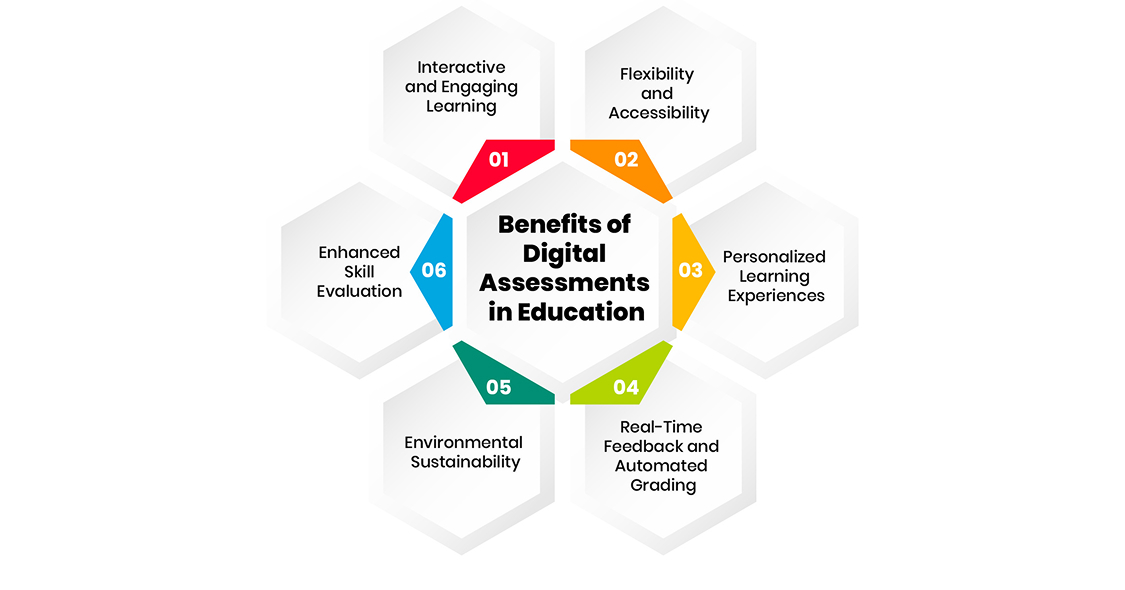How Digital Assessments Enhance Learning Outcomes in Today's Education
March 31, 2025The increasing adoption of digital assessments in K-12 education reflects their growing significance in modern learning. Beyond measuring student progress, digital assessments help educational institutions ensure compliance with quality standards and provide valuable insights for improving learning outcomes. They also enhance accountability and transparency in education technology, making them an essential tool for both educators and decision-makers. Unlike traditional assessments that often focus solely on performance, digital assessments are designed to promote deeper learning by encouraging knowledge application and long-term retention.
However, integrating digital assessments into classrooms can seem overwhelming for both teachers and students. Many struggle with adapting to new technologies and understanding how to effectively implement these tools. The key lies in leveraging digital advancements strategically to create a structured and supportive environment for assessments. A well-planned approach can help ease this transition, ensuring that digital assessments not only measure knowledge but also enhance critical thinking, problem-solving, and overall learning experiences.
The Growing Importance of Digital Assessments in Education
Assessments play a crucial role in ensuring effective learning by helping educators track student progress and refine teaching strategies. A well-designed assessment framework not only measures knowledge but also supports skill development and critical thinking. However, traditional assessment methods often present limitations, as they primarily emphasize memorization rather than deeper understanding. These conventional approaches may fail to address diverse learning needs, provide real-time feedback, or develop student engagement, making it difficult to support individualized growth.
Digital assessments have emerged as a transformative solution to these challenges, offering dynamic, adaptive, and interactive evaluation methods. Unlike static tests, digital assessments leverage technology to provide instant feedback, personalize learning experiences, and accommodate various learning styles. They encourage continuous learning by enabling students to reflect on their performance and apply feedback to improve their understanding. Furthermore, these assessments facilitate data-driven decision-making for educators, allowing them to refine their teaching approaches and enhance student outcomes. By integrating digital assessments into modern education, institutions can create a more inclusive and effective learning environment that builds both academic success and critical thinking skills.
The Transformative Benefits of Digital Assessments in Education
Digital assessments have revolutionized the way learning is measured, offering a more interactive, personalized, and efficient approach compared to traditional evaluation methods. By leveraging technology, these assessments enhance student engagement, provide real-time feedback, and support adaptive learning, making education more effective and accessible.

-
1.Interactive and Engaging Learning
Digital assessments integrate simulations, multimedia content, and gamified elements to create an engaging learning experience. Features such as videos, animations, and interactive quizzes encourage student participation, making assessments more dynamic compared to traditional pen-and-paper methods. Simulations allow learners to apply their knowledge in real-world scenarios, improving comprehension and retention. -
2.Flexibility and Accessibility
One of the key advantages of digital assessments is their ability to accommodate different learning paces and schedules. Students can access assessments anytime and from anywhere, reducing the stress associated with fixed-time exams. Formative assessments provide continuous feedback on progress, while summative assessments measure performance against academic benchmarks at institutional, national, or global levels. -
3.Personalized Learning Experiences
AI-powered digital learning platforms adjust assessments based on individual performance. By analyzing student responses, these systems refine question difficulty and suggest relevant learning materials. Instant feedback enables learners to identify their weaknesses and improve accordingly. Additionally, adaptive learning paths ensure that students receive content suited to their needs, enhancing academic outcomes. -
4.Real-Time Feedback and Automated Grading
Unlike traditional exams that require manual evaluation, digital assessments provide instant feedback, allowing students to track their progress immediately. AI-driven grading systems analyze responses and generate insights, freeing educators from time-consuming administrative tasks. This enables teachers to focus on instructional strategies and individualized student support. -
5.Environmental Sustainability
The adoption of digital assessments significantly reduces paper consumption, printing costs, and logistical challenges associated with traditional exams. By minimizing resource usage, educational institutions contribute to sustainability efforts while embracing modern technology-driven learning methods. -
6. Enhanced Skill Evaluation
Digital assessments allow for a broader evaluation of skills beyond memorization. They can assess problem-solving, critical thinking, and analytical abilities through diverse question formats. Video-based assessments, simulations, and project-based tasks encourage active learning and deeper engagement, ensuring that students are not just recalling information but applying it effectively.
Best Practices for Implementing Digital Assessments in Education
The transition to digital assessments requires careful planning to ensure a smooth and effective implementation. By gradually integrating digital tools, providing necessary training for educators, and adopting diverse assessment methods, institutions can enhance learning outcomes while making assessments more engaging and accessible.

-
Start Small and Gradually Transition
Shifting to digital assessments doesn’t have to be an immediate overhaul. Instead, starting with a few simple, low-stakes digital tasks allows both educators and students to adapt to the new format. Initial assessments can include short quizzes or interactive assignments that familiarize students with digital tools without overwhelming them. Open communication about the benefits of digital assessments, such as instant feedback and personalized learning paths, helps ease any apprehension. Additionally, ensuring that all students have access to the necessary technology and internet connectivity is crucial for inclusivity. -
Equip Educators with the Right Tools and Training
For digital assessments to be effective, educators need both the right tools and comprehensive training. Choosing user-friendly platforms with features like automated grading, real-time feedback, and customizable assessment options simplifies the transition. However, having access to technology alone is not enough—teachers must be trained to utilize these platforms efficiently. Training programs should not only cover technical aspects but also focus on best practices for designing effective digital assessments that go beyond simple knowledge recall. A shift in mindset is essential, encouraging educators to use digital tools for more personalized and interactive evaluation methods. -
Diversify Assessment Methods
Digital assessments offer the flexibility to accommodate different learning styles, ensuring a more inclusive evaluation process. Instead of relying solely on multiple-choice tests, educators can incorporate open-ended questions, multimedia-based tasks, and interactive simulations. Adaptive assessments adjust difficulty levels in real time, providing a more accurate measure of student progress. Gamification elements, such as leaderboards and interactive problem-solving tasks, increase engagement and motivation. Collaborative digital assessments also encourage teamwork and critical thinking, making learning a more dynamic experience. -
Align Assessments with Learning Objectives
Effective digital assessments should measure more than just memorization—they should align with learning goals and encourage critical thinking. Designing assessments that test problem-solving abilities, analytical skills, and practical application of knowledge ensures a more comprehensive evaluation. Educators should also be mindful of factors like accessibility, potential algorithmic bias, and special learning needs when designing assessments to create a fair and equitable learning environment.
Shaping the Future of Assessments
The landscape of educational assessments is undergoing a significant transformation with advancements in artificial intelligence (AI) and data analytics. Traditional evaluation methods are evolving into intelligent, adaptive systems that provide personalized feedback, track learning progress, and enhance student engagement. AI-powered assessments enable educators to identify learning gaps early, recommend targeted resources, and create an effective feedback loop that refines both teaching and learning strategies.
Integrating digital assessments with eLearning platforms allows for dynamic and interactive evaluations customized to individual learners. Data-driven insights help educators monitor progress over time, offering a comprehensive view of student achievement. Technologies like machine learning and virtual reality further enhance assessments by making them immersive and engaging. AI-driven grading tools streamline evaluation processes, automating complex assessments and saving educators valuable time. Additionally, adaptive assessments adjust question difficulty based on student proficiency, ensuring accurate measurement of knowledge and skills.
As the educational landscape continues to evolve, institutions must embrace digital assessment innovations to stay competitive. Future assessments will go beyond traditional evaluations, becoming an essential part of the learning process that nurtures self-directed learning. By adopting advanced digital solutions, educators can enhance teaching effectiveness, optimize student success, and pave the way for a more intelligent, data-driven education system.
Conclusion
Digital assessments are transforming education by making evaluations more interactive, insightful, and learner-centric. Beyond measuring knowledge, they enhance critical thinking, adaptability, and personalized learning experiences. As technology advances, these assessments will continue to shape a more efficient and inclusive education system, empowering both educators and students to achieve better learning outcomes.




